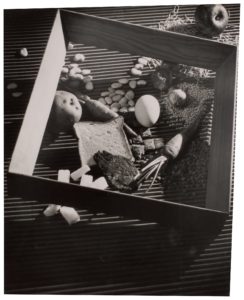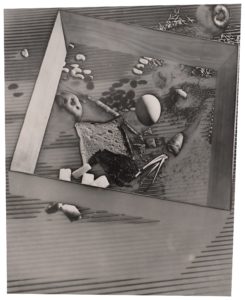György Kepes & M. Halberstadt
Hungarian/American, 1906-2001—1919-2000
About
György Kepes & M. Halberstadt
Hungarian/American, 1906-2001—1919-2000
György Kepes & M. Halberstadt collaborated creatively during their time at the New Bauhaus school in Chicago. Their investigations resulted in innovative camera images that included multiple exposures, negative reversal and solarized prints
György Kepes was born in Selyp, Hungary and studied under painter Istvan Csók at the Royal Academy of Fine Arts in Budapest. Although trained in impressionism, Kepes quickly developed an interest in more avant-garde and abstract visual styles, in particular the visual effects of light. He began experimenting with photograms – a technique where images are made by placing objects onto photosensitive paper and then exposing the paper to light. As Kepes became increasingly interested in visual theory and technology, he used devices such as x-ray machines, electron microscopes, sonar, and radar in order to capture unseen images
In 1930 Kepes moved to Berlin to work as a publication, exhibition and stage designer. It was there that he was invited to join the design studio of artist and Bauhaus professor László Moholy-Nagy, where the two collaborated for years to come. In 1937, alongside Moholy-Nagy, Kepes emigrated to the U.S. and was subsequently invited to head the curricular area in Light and Color at the New Bauhaus, Chicago, now known as the Institute of Design. In 1944 Kepes published the Language of Vision, an influential text, which outlined his theories on visual communication through photography, cinema and design. He went on to teach at MIT in 1946, and in 1967 he founded MIT’s Center for Advanced Visual Studies (CAVS).
Throughout his years at MIT Kepes continued to paint as well as explore a variety of photographic techniques including: double exposures and photograms; as well as going on to develop his “photo-drawings.” In his “photo-drawings,” Kepes experimented with applying paint to glass plates, then shining light through them, using them as one would use a traditional photographic negative. Many of the resulting images embody a combination of his interest in science and technology with his passion for art and design. Kepes’ work in both the sciences and arts is considered influential and innovative, and his theories of light, design and imagery continue to be relevant today.
M. Halberstadt (1919-2000) was a recipient of one of the first Rockefeller Foundation scholarships given by the School of Design in the Fall of 1940. Already an accomplished photographer and photo-technician from Boston, he became a teaching assistant to both Kepes and Moholy. In addition, he photographed Moholy’s plexiglass sculptures and printed many of Moholy’s Berlin camera images including a limited edition in 1941 of Moholy’s famous Radio Tower, Berlin, 1928 image for New York’s Museum of Modern Art. Halberstadt’s own photographic investigations at the school resulted in his innovative camera images that included multiple exposures, negative reversal prints, and an engaging use of solarization.
Collaborative works by György Kepes & M. Halberstadt were included in the exhibition New Bauhaus in America at the Robert Koch Gallery.

